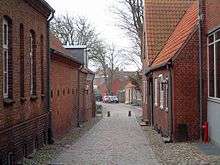Ringkøbing




| Wikimedia Commons has media related to Ringkøbing. |
Ringkøbing is a town in Ringkøbing-Skjern municipality in Region Midtjylland on the west coast of the Jutland peninsula in west Denmark. It has a population of 9,717 (1 January 2014).[1]
History

Archeological finds suggest that the town was founded in the 13th century. At that time it was the only real harbour town along the Danish west coast, being sheltered from the North Sea by the wall of Holmsland Dunes (Holmsland Klit).
In the 17th century the exit out of Ringkøbing Fjord started moving south, caused by wind and tide; Ringkøbing was then cut off from the sea. It was not until the beginning of the 20th century that a new opening to the sea was created at the town of Hvide Sande, in nearby Holmsland municipality. This enabled boats to come to Ringkøbing again from the North Sea.
The name Ringkøbing means "The market town near Rindum". Already in the 11th century, a church was built in the small village Rindum. The village is probably even older, and there has been found proof of settlements dating as far back as the 6th century.
At the end of World War 2 Ringkøbing was involved in the testing of German WW2 V-weapons. British soldiers were stationed there, including members of the British Artillery Regiment radar experts. In October 1945 the British monitored the accuracy of German Vergeltungswaffen (V) weapons that the British fired from a base in Cuxhaven, Saxony, Germany, to Ringkøbing. This was done as part of the post-WW2 justice process, in order to establish whether the use of the V weapons constituted indiscriminate killing of civilians. In fact, they proved to be very accurate so this is one charge the Nazis escaped.
Main sights
Today the centre of Ringkøbing has some quaint old streets, most of which lead towards the water of the fjord.
Ringkøbing Church was built in the early 15th century, and its tower, which is wider on top than on the bottom, was erected ca. 1550. The church houses two organs: the oldest in the west pulpit was built by Demant & Son in 1861 with a baroque facade from 1633; the other from 1974 is by Frobenius & Sons. As the result of a restoration in 1995-1996, the church has a number of modern features, including an altarpiece by Arne Haugen Sørensen and a glass baptismal font.
Economy
Ringkjøbing Landbobank is headquartered in Ringkøbing.
External links
- The Official Tourist page for Ringkøbing
- West Jutland tourism information, covering Ringkøbing area
- Municipal statistics: NetBorger Kommunefakta, delivered from KMD aka Kommunedata (Municipal Data)
- Municipal mergers and neighbors: Eniro new municipalities map
References
Coordinates: 56°05′N 8°15′E / 56.083°N 8.250°E